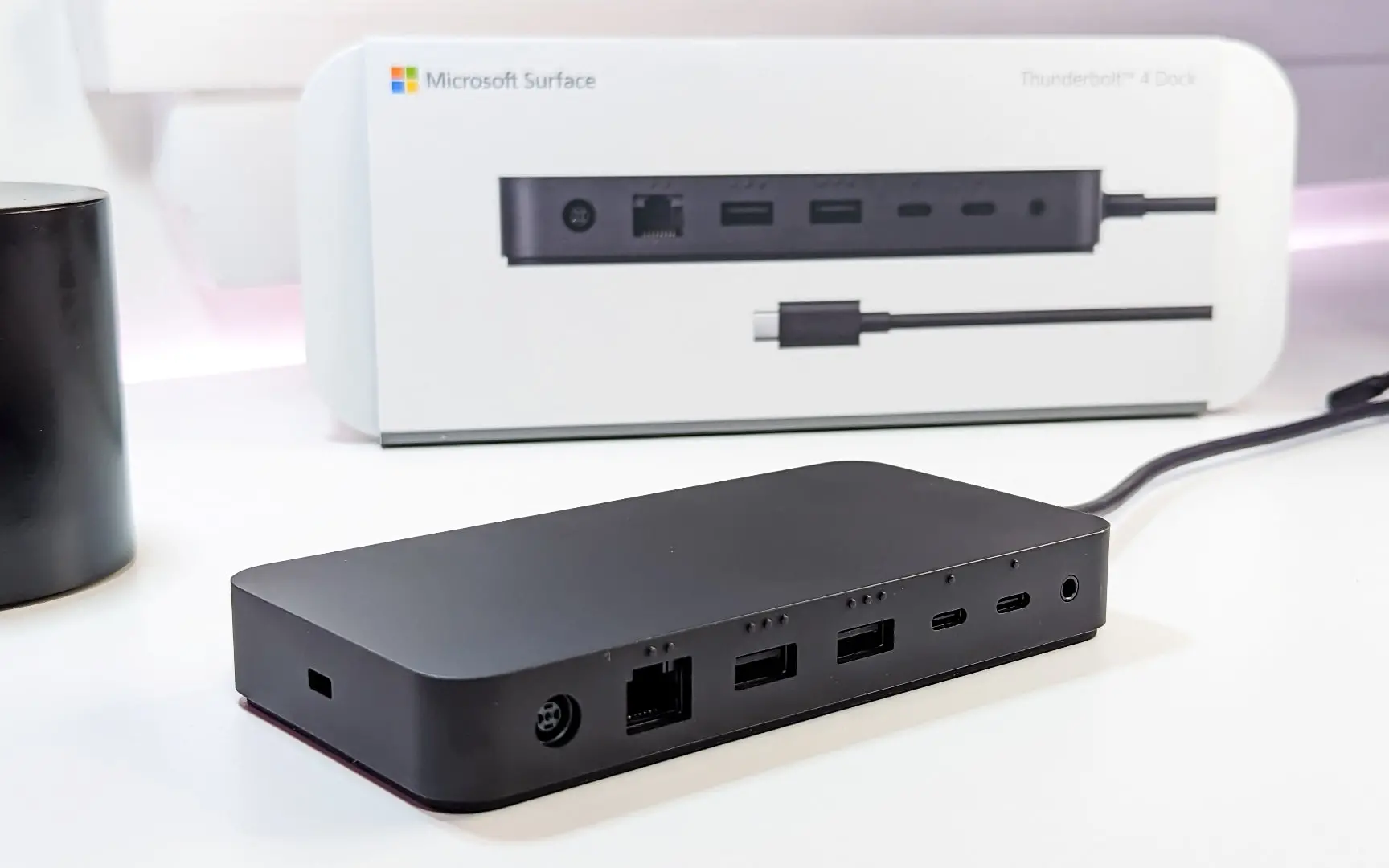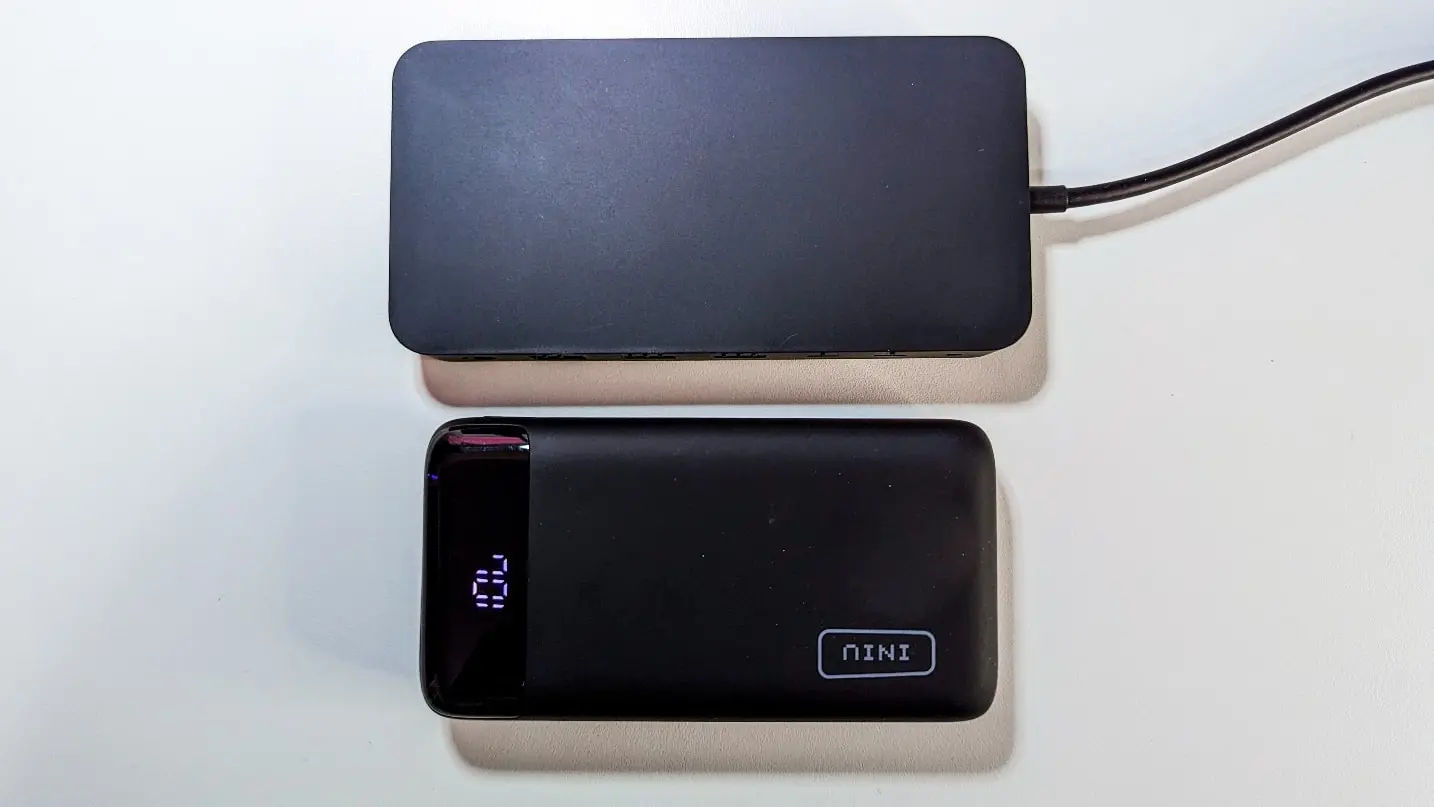
The Microsoft Surface Thunderbolt 4 Dock is an all-in-one connection hub designed to help users consolidate all their peripherals in one location. Today, it’s common for people to use laptops as their main computing device. They allow us to be mobile while still having the ability to work, take video calls, and browse the internet at our convenience. However, when you’re at home or at work, a limitation of our laptops is the number of available connection ports. This is the problem that the Surface Dock set out to solve. In today’s review, I’ll look at the dock’s setup, design, performance, and share my final thoughts.
Unboxing the Microsoft Surface Thunderbolt 4 Dock
The Microsoft Surface Thunderbolt 4 Dock comes in very nice, small, and sustainable packaging. It’s nice to see that Microsoft used more conservative packaging and wasted no space in the design. The contents of the Surface Thunderbolt 4 box are straightforward. Inside the box you’ll find the Surface Thunderbolt 4 Dock, a power supply, and some documentation. Since all of the packaging is recyclable paper, I liked that users can easily recycle the box.

Small and minimalist design
The Surface Thunderbolt 4 Dock has a small footprint at 5.91″ x 2.95″ x 0.84″ (L x W x H). It’s roughly the same size as a portable power bank. The small size actually hides just how many connections the Surface Thunderbolt 4 can handle.
An immediately visible change of the Dock is that it has a USB-C connection. Older Microsoft Surface docks were made to be compatible with Surface laptops and tablets via the Surface Connect cable. The change to a USB-C connection makes this docking station compatible with any computer that supports Thunderbolt 4. In my case, I was able to connect my Windows laptop, MacBook Air, and Chromebook to the Surface Thunderbolt 4 Dock.
Plentiful connectivity for all your needs
On the front, there is one USB-C Thunderbolt 4 and one USB-A 3.1 port. Along the back, there is a power supply connection, a Ethernet port (2.5Gbit/s), two USB-A 3.1 ports, two USB-C Thunderbolt 4 ports, and a 3.5mm headphone jack. Above each connection point, you’ll notice some raised bumps. This is a thoughtful design by Microsoft, the bumps indicate the connection type, allowing you to know what connection you’re reaching for without having to turn the dock around.
With all these connection points, it feels like the Surface Thunderbolt 4 has all its bases covered. However, one challenge I found myself running into was that none of my monitors had a USB-C Thunderbolt 3 or 4 connection. My monitors all use HDMI or DisplayPort connections, so it would’ve been nice if the dock had one of these connections. For anyone that has an older monitor, they will need an HDMI or DisplayPort to USB-C adapter to connect to the Surface Thunderbolt 4 Dock.
Day-to-day with the Microsoft Surface Thunderbolt 4 Dock
Setting up the Thunderbolt 4 Dock is incredibly simple. Users just need to connect their peripherals to the Surface Thunderbolt 4 Dock. In total, it took me about 10 minutes before my desktop setup was complete. After, my desk looked completely different. There was much less clutter, I no longer had stray cables and USB-C dongles strewn across my desk.
Productivity
As someone who uses multiple laptops for a variety of productivity purposes, the Surface Thunderbolt 4 Dock has made my life significantly more simple. With the dock, I can connect my wireless mouse and keyboard, external storage, headphones, laptop charger, and, of course, my computer monitor.
The Surface Thunderbolt 4 has a throughput of 40Gbps, which is enough to support a video signal for two 4K monitors at a 60Hz refresh rate. The dock is even capable of charging your laptop while plugged in. According to Microsoft’s website, the Surface Thunderbolt 4 Dock is capable of outputting 96 watts, which is enough to charge any laptop.
Using this dock I can seamlessly transition between laptops while continuing to use the same peripherals. This has made life simpler and has helped me maintain a productive workflow. Without the Surface Thunderbolt 4 Dock, life is noticeably more tedious. I would have to manually disconnect and reconnect my devices every time I switched laptops.
The simplicity and ease of transferring my work peripherals between computers cannot be understated. I absolutely love using the Surface Thunderbolt 4 Dock as a part of my day-to-day workflow. As an added benefit, the Surface Thunderbolt 4 Dock has also freed up all the connection points on all of my laptops. This has resulted in a much cleaner and less cluttered desk space.
Gaming
Playing games is one of the ways that I relax and de-stress. If your gaming setup supports Thunderbolt 4, the Microsoft Surface Thunderbolt 4 Dock is a great companion. Thunderbolt 4 is capable of supporting refresh rates on monitors up to 240Hz, which is fast enough to satisfy even the most hardcore gamers. In my testing, I played a few of my favorite games, including Call of Duty and Tomb Raider. Gaming was smooth and didn’t notice any stuttering or slowdowns when using the Surface Thunderbolt 4 Dock.

Final thoughts
The Microsoft Surface Thunderbolt 4 Dock is a great device that acts as an all-in-one hub for your workstation peripherals. I’m impressed that the dock can support two 4K monitors while still charging your laptop at 96 watts. I absolutely love how clean and minimalist the dock makes my desk, and I love how simple it is to swap between my devices while keeping all the same peripherals.
If you’re looking to streamline your workstation or you use a the same workspace as your roommates or family, then you absolutely need to get the Microsoft Surface Thunderbolt 4 Dock. You can also check out more Surface accessories for your computer on bestbuy.ca.



